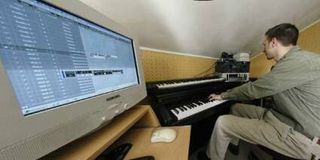Creative's E-MU 1820 Goes Home Studio Pro
In Practice, In The Studio
There's not much point in testing this kind of sound card only under laboratory measurement conditions. So we performed practical recording tests in a home studio, which is where it is most likely to be used. The tests were made using the bundled software, Cubase VST 5.1 (special E-MU edition) and Wavelab Lite.

The minimum stated configuration is not very demanding:
- Processor : Pentium III or AMD K6 500 MHz or better
- Memory: 128 Mb
- PCI 2.1 connector of choice
- Graphics card: XVGA (1024X768)
- Operating system: Windows 2000 SP4, Windows XP SP1 or more recent
To work comfortably, you would probably need something better. The only slightly odious requirement is the operating system. In practice, it would be unrealistic to use anything but the latest version of WindowsXP. Naturally, the card is compatible with all the usual audio applications. You have three types of drivers: WDM, ASIO multimedia, and ASIO 2.
Obviously, you will need time to familiarize yourself with the software and learn how to use it on the 1820. But it's very simple to install the card and we encountered no irritating glitches. Everything worked immediately and we didn't have to make any weird or obscure choices from the dialog box. And this was on an "as is" computer, not a new one outfitted only with a select number of audio applications. While we can't guarantee you will get the same result, it's a nice capability, especially since some cards are very fussy, to the point of being jealous of other programs installed on the same machine.


Several musical instruments and some studio equipment, a PC and a E-MU 1820 - that's all you need to start recording music!
Stay on the Cutting Edge
Join the experts who read Tom's Hardware for the inside track on enthusiast PC tech news — and have for over 25 years. We'll send breaking news and in-depth reviews of CPUs, GPUs, AI, maker hardware and more straight to your inbox.
Current page: In Practice, In The Studio
Prev Page Behavior At 48 KHz/24 Bits Next Page In Practice, In The Studio, ContinuedMost Popular

